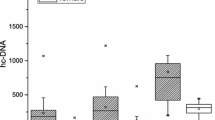Abstract
Granulocyte-macrophage colony stimulating factor (GMCSF) promotes the growth of granulocytes and macrophages from undifferentiated bone marrow cells and modulates the oxidative responses of polymorphonuclear leukocytes (PMN) to endogenous chemoattractants. We found that,in vitro, naturally occurring glycolsylated human GMCSF does not disturb the resting canine PMN membrane potential, may attentuate PMN oxidative responses to PMA, and is, to a small degree, chemotaxigenic. GMCSF, however, inhibits PMN chemotaxis to zymosanactivated plasma (ZAP). Compared to temperature controls, GMCSF (1-100 U/ml) produced up to 1.5-fold increases in H2O2 production after 15 minutes, while phorbol myristate acetate (PMA) treated cells increased H2O2 production 8–12-fold after 15 minutes. Preincubation of cells with GMCSF (1–100 U/ml) prior to PMA stimulation significantly reduced the H2O2 levels induced by PMA. H202 production was inhibited up to 15% after 15 minutes of GMCSF preincubation and up to 40% after 60 minutes of preincubation. As a chemotaxigenic agent, GMCSF (10–1000 U/ml) was able to elicit 49%–102% increases in quantitative cellular migration, compared to random migration. Total cellular chemotaxis to GMCSF was < 30% of the response to ZAP. Preincubation of PMNs with GMCSF for 15 minutes significantly inhibited ZAP-induced cellular migration. Human GMCSF does not appear to activate canine PMNin vitro and may actually down-regulate PMN inflammatory responses.
Similar content being viewed by others
Abbreviations
- FL:
-
fluorescence intensity
- GMCSF:
-
granulocyte-macrophage colony-stimulating Factor
- HBSS:
-
Hanks balanced salt solution
- H2O2 :
-
hydrogen peroxide
- MP:
-
membrane potential
- PMA:
-
phorbol myristate acetate
- PMN:
-
polymorphonuclear leukocyte
References
Gasson JC, Weisbart RH, Kaufman SE, Clark SC, Hewick RM, Wong GG, Golde DW. Purified human granulocyte-macrophage colony-stimulating factor: direct action on neutrophils. Science 1984; 226: 1339–42.
Fleischmann J, Golde DW, Weisbart RH, Gasson JC. Granulocyte-macrophage colony-stimulating factor enhances phagocytosis of bacteria by human neutrophils. Blood 1986; 68: 708–11.
Weisbart RH, Kwan L, Golde DW, Gasson JC. Human GM-CSF primes neutrophils for enhanced oxidative metabolism in response to the major physiological chemoattractants. Blood 1987; 69: 18–21.
Guthrie LA, McPhail LC, Hemson PM, Johnston RB. Priming of neutrophils for enhanced release of oxygen metabolites by bacterial lipopolysaccharides. J Exp Med 1984; 160: 1656–60.
Bender GB, McPhail LC, Van Epps DE. Exposure of human neutrophils to chemotactic factors potentiates activation of the respiratory burst enzyme. J Immunol 1983; 136: 2316–20.
Cross AS, Lowell GH, Palmblad J, Sadoff JC, Young L, Berger M. Mechanism of priming of human neutrophils by a soluble lymphoblastoid cell factor. J Immunol 1985; 135: 2074–83.
Metcalf D, Begley CG, Johnson GR, Nicola NA, Vadas MA, Lopez AF, Williamson DJ, Wong GG, Clark SC, Wang EA. Biological properties in vitro of a recombinant human granulocyte-macrophage colony-stimulating factor. Blood 1986; 67: 37–45.
Donahue RE, Wang EA, Stone DK, Kamen R, Wong GG, Sehgal PK, Nathan DG, Clark SC. Stimulation of haematopoiesis in primates by continuous infusion of recombinant human GM-CSF. Nature 1986; 321: 872–5.
Nienhuis AW, Donahue RE, Karisson S, Clark SC, Agricola B, Antinoff N, Pierce JE, Turner P, Anderson WF, Nathan DG. Recombinant human granulocytemacrophage colony-stimulating factor (GM-CSF) shortens the period of neutropenia after autologous bone marrow transplantation in a primate model. J Clin Invest 1987; 80: 573–7.
Monroy RL, Skelly RR, MacVittie TA, Davis TA, Sauber JJ, Clark SC, Donahue RE. The effect of recombinant GM-CSF on the recovery of monkeys transplanted with autologous bone marrow. Blood 1987; 5: 1696–9.
Redl H, Flynn PJ, Lamche H, Schiesser A, Schlag G, Hammerschmidt DE. Aggregation, chemotaxis, and chemiluminescence of canine granulocytes. Inflammation 1980; 7: 67–80.
Bass DA, Parce JW, Dechatelet LR, Szejda P, Seeds MC, Thomas M. Flow cytometric studies of oxidative product formation by neutrophils; a graded response to membrane stimulation. J Immunol 1983; 130: 1910–7.
MacVittie TJ, D'Alesandro MM, Kaffenberger W, Patchen ML, Donahue RE.Invivo effects of infusion into the primates of recombinant human granulocyte-macrophage colony stimulating factor (rhGM-CSF): marrow granulopoiesis and activation of circulating neutrophils. Exp Hemat See, Abstract, 1986.
Mayer P, Lam C, Obenaus H, Liehl E, Besemer J. Recombinant human GM-CSF induces leukocytosis and activates peripheral blood polymorphonuclear neutrophils in nonhuman primates. Blood 1987; 70: 206–13.
Weisbart RHR, Golde DW, Gasson JC. Biosynthetic human GM-CSF modulates the number and affinity of neutrophil f-met-leu-phe receptors. J Immunol 1986; 137: 3584–7.
Fletcher MP, Gasson JC. Enhancement of neutrophil function by granulocyte-macrophage colony-stimulating factor involves recruitment of a less responsive subpopulation. Blood 1988; 71: 652–8.
Sullivan R, Fredette JP, Leavitt JL, Gadenne AS, Griffin JD, Simons ER. Effects of recombinant human granulocyte-macrophage colony-stimulating factor (GM-CSFrh) on transmembrane electrical potentials in granulocytes: relationship between enhancement of ligand-mediated depolarization and augmentation of superoxide anion (O2 −) production. J Cell Physiol 1989; 139: 361–9.
Lopez AF, Williamson DJ, Gamble JR, Begley CG, Harlan JM, Klebanoff SJ, Wlatersdorph A, Wong G, Clark SC, Vadas MA. Recombinant human granulocytemacrophage colony-stimulating factor stimulates in vitro mature human neutrophil and eosinophil function, surface receptor expression, and survival. J Clin Invest 1986; 78: 1220–8.
Author information
Authors and Affiliations
Additional information
Supported by the Armed Forces Radiobiology Research Institute, Defense Nuclear Agency, under work unit No. 00082. Views presented in this paper are those of the authors; no endorsement by the Defense Nuclear Agency has been given or should be inferred. Research was conducted according to the principles enunciated in the “Guide for the Care and Use of Laboratory Animals” prepared by the Institute of Laboratory Animal Resources, National Research Council.
Rights and permissions
About this article
Cite this article
D'Alesandro, M.M., Gruber, D.F., O'Halloran, K.P. et al. In vitro modulation of canine polymorphonuclear leukocyte function by granulocyte-macrophage colony stimulating factor. Biotherapy 3, 233–239 (1991). https://doi.org/10.1007/BF02171686
Received:
Accepted:
Issue Date:
DOI: https://doi.org/10.1007/BF02171686




